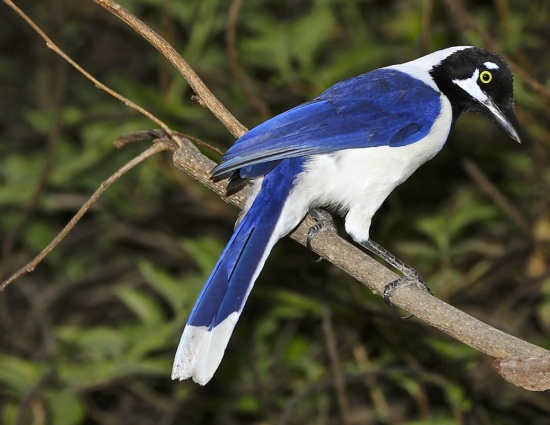- Cyanocorax mystacalis
Identification
33cm (132 in)
- Feathers of forehead are stiffly errected and short-tufted, creating an inconspicuous frontal crest
- Black forehead, crown, side of head, side of neck, throat and upper breast
- Small white patch above eye, elongated white malar patch
- White nape, hindneck, upper mantle, lower side of neck and underparts
- Cyan-blue upperparts
- White tail except for central feather pair which is cyan-blue with white tips
- Bright lemon-yellow eye
- Black bill and legs
Sexes similar. Juveniles have a purplish-blue malar patch, a brown eye and lack the white spot above the eye. The color of the malar fades to whitish and the spots above the eye starts to develop before the color of the eye changes.
Similar species
Similar to Cayenne Jay but with much more white in tail and ranges don't overlap.
Distribution
Found in southwest Ecuador and northwest Peru.
Tumbesian endemic with a restricted range. Uncommon to locally common, seems to have declined.
Taxonomy
This is a monotypic species[1].
Possibly closely related to Cayenne Jay and/or Tufted Jay.
Habitat
Dry or moist lowland forests, particularly thick growth near streams and rivers. Found from sea coast up to 2600m.
Behaviour
Diet
Feeds on beetles, ants, other insects and seeds. Reported raiding a nest of Pacific Hornero.
Often seen on ground and approaches human settlements more frequently than other jays.
Breeding
Breeding reported from February to March. One nest described in a large tree adjacent to a village. No other information.
Movements
A sedentary species.
References
- Clements, J. F., T. S. Schulenberg, M. J. Iliff, D. Roberson, T. A. Fredericks, B. L. Sullivan, and C. L. Wood. 2018. The eBird/Clements checklist of birds of the world: v2018. Downloaded from http://www.birds.cornell.edu/clementschecklist/download/
- Del Hoyo, J, A Elliott, and D Christie, eds. 2009. Handbook of the Birds of the World. Volume 14: Bush-shrikes to Old World Sparrows. Barcelona: Lynx Edicions. ISBN 978-8496553507
Recommended Citation
- BirdForum Opus contributors. (2024) White-tailed Jay. In: BirdForum, the forum for wild birds and birding. Retrieved 26 October 2024 from https://www.birdforum.net/opus/White-tailed_Jay





